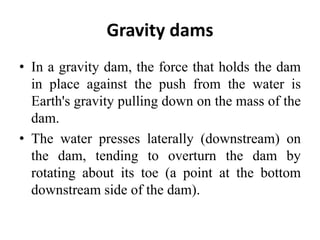Infrastructure of Dam
- 1. DEPARTMENT OF CIVIL ENGINEERING Infrastructure mainly consisting of Dams, Er. Ramprasad Kumawat M.Tech
- 2. Dam • A dam is a barrier that stops or restricts the flow of surface water or underground streams. • Reservoirs created by dams not only suppress floods but also provide water for activities such as irrigation, human consumption, industrial use, aquaculture, and navigability. • Hydropower is often used in conjunction with dams to generate electricity.
- 3. • A dam can also be used to collect or store water which can be evenly distributed between locations.
- 4. Types of dams • Dams can be formed by human agency, natural causes, or even by the intervention of wildlife such as beavers. • Man-made dams are typically classified according to their size (height), intended purpose or structure.
- 5. By structure • Based on structure and material used, dams are classified as easily created without materials, • arch-gravity dams, • embankment dams or • masonry dams, with several subtypes.
- 6. Arch dams • In the arch dam, stability is obtained by a combination of arch and gravity action. • If the upstream face is vertical the entire weight of the dam must be carried to the foundation by gravity, while the distribution of the normal hydrostatic pressure between vertical cantilever and arch action will depend upon the stiffness of the dam in a vertical and horizontal direction.
- 7. • When the upstream face is sloped the distribution is more complicated. The normal component of the weight of the arch ring may be taken by the arch action, while the normal hydrostatic pressure will be distributed. • Two types of single-arch dams • the double-curvature
- 8. Gravity dams • In a gravity dam, the force that holds the dam in place against the push from the water is Earth's gravity pulling down on the mass of the dam. • The water presses laterally (downstream) on the dam, tending to overturn the dam by rotating about its toe (a point at the bottom downstream side of the dam).
- 9. • For this type of dam, it is essential to have an impervious foundation with high bearing strength. • Uplift pressures are hydrostatic pressures caused by the water pressure of the reservoir pushing up against the bottom of the dam. • If large enough uplift pressures are generated there is a risk of destabilizing the concrete gravity dam.
- 10. Arch-gravity dams • A gravity dam can be combined with an arch dam into an arch-gravity dam for areas with massive amounts of water flow but less material available for a pure gravity dam. • The inward compression of the dam by the water reduces the lateral (horizontal) force acting on the dam.
- 11. barrage dam • A barrage dam is a special kind of dam that consists of a line of large gates that can be opened or closed to control the amount of water passing the dam. • The gates are set between flanking piers which are responsible for supporting the water load, and are often used to control and stabilize water flow for irrigation systems.
- 12. Embankment dams • Embankment dams are made of compacted earth, and are of two main types: "rock-fill" and "earth-fill". • Like concrete gravity dams, embankment dams rely on their weight to hold back the force of water.
- 13. Cofferdams • A cofferdam is a barrier, usually temporary, constructed to exclude water from an area that is normally submerged. • Made commonly of wood, concrete, or steel sheet piling, cofferdams are used to allow construction on the foundation of permanent dams, bridges, and similar structures. • When the project is completed, the cofferdam will usually be demolished or removed unless the area requires continuous maintenance. (See also causeway and retaining wall.)
- 14. Natural dams • Dams can also be created by natural geological forces. • Lava dams are formed when lava flows, often basaltic, intercept the path of a stream or lake outlet, resulting in the creation of a natural impoundment.
- 15. • An example would be the eruptions of the Uinkaret volcanic field about 1.8 million– 10,000 years ago, which created lava dams on the Colorado River in northern Arizona in the United States. • The largest such lake grew to about 800 km (500 mi) in length before the failure of its dam.
- 16. • THANKS!















